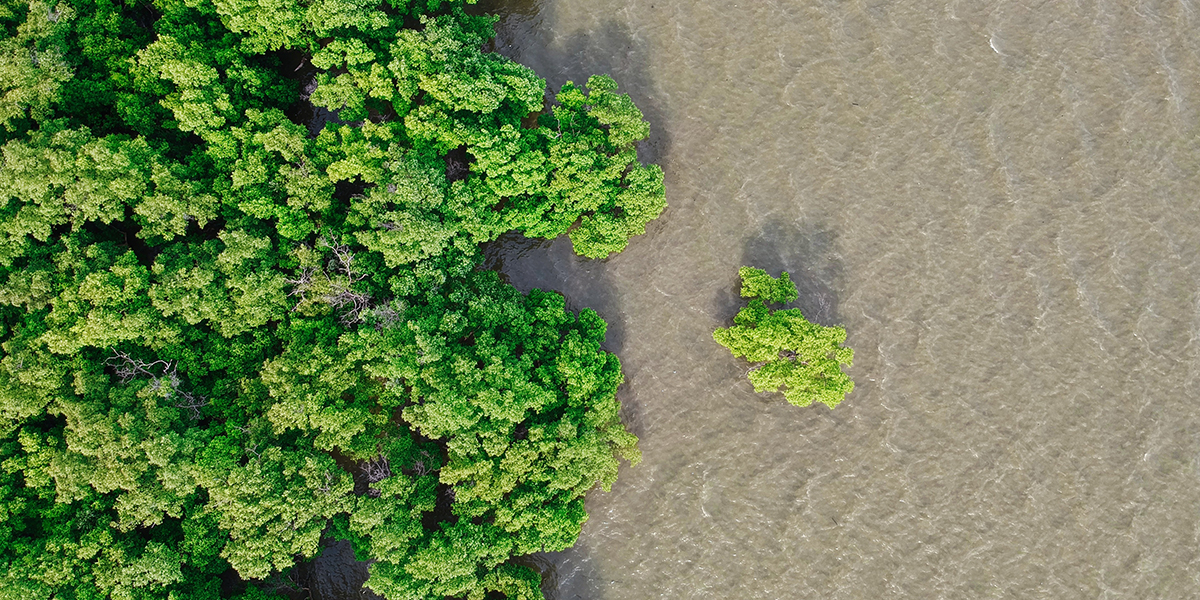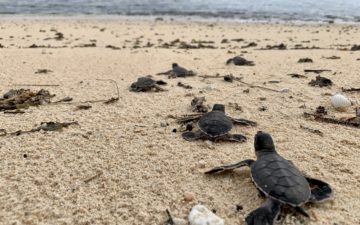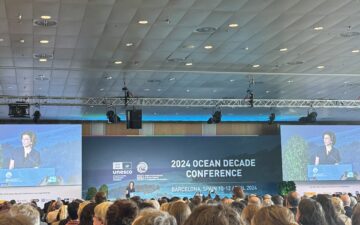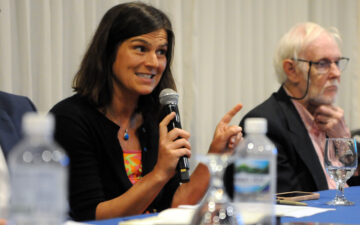Blue carbon is the carbon dioxide captured by the world’s ocean and coastal ecosystems. This carbon is stored in the form of biomass and sediments from mangroves, tidal marshes and seagrass meadows. Blue carbon is the most effective, yet overlooked, method for long term sequestration and storage of carbon. Of equal importance, investment in blue carbon provides invaluable ecosystem services that contribute to people’s ability to mitigate and adapt to the impacts of climate change.
Here we have compiled some of the best resources on this topic.
Fact Sheets and Flyers
A Blue Carbon Fund – The ocean equivalent of REDD for carbon sequestration in coastal states. (Flyer)
This is a useful and condensed summary of the report by the UNEP and GRID-Arendal, including the role of the critical role the ocean plays in our climate and the next steps to include it in climate change agendas.
Blue Carbon: A Story Map from GRID-Arendal.
An interactive story book on the science of blue carbon and the policy recommendations for its protection from GRID-Arendal.
AGEDI. 2014. Building Blue Carbon Projects – An Introductory Guide. AGEDI/EAD. Published by AGEDI. Produced by GRID-Arendal, A Centre Collaborating with UNEP, Norway.
The report is an overview of Blue Carbon science, policy and management in collaboration with United Nation’s Environmental Programme. Blue carbon’s financial and institutional impact as well as capacity building for projects is reviewed. This includes case studies in Australia, Thailand, Abu Dhabi, Kenya and Madagascar.
Pidgeon, E., Herr, D., Fonseca, L. (2011). Minimizing Carbon Emissions and Maximizing Carbon Sequestration and Storage by Seagrasses, Tidal Marshes, Mangroves – Recommendations from the International Working Group on Coastal Blue Carbon
Highlights the need for 1) enhanced national and international research efforts of coastal carbon sequestration, 2) enhanced local and regional management measures based on current knowledge of emissions from degraded coastal ecosystems and 3) enhanced international recognition of coastal carbon ecosystems. This brief flyer calls for immediate action towards the protection of seagrasses, tidal marshes and mangroves.
Restore America’s Estuaries: Coastal Blue Carbon: A new opportunity for Coastal Conservation
This handout covers the importance of blue carbon and the science behind the storage and sequestration of greenhouse gases. Restore America’s Estuaries reviews the policy, education, panels and partners they are working on to advance coastal blue carbon.
Press Releases, Statements, and Policy Briefs
Blue Climate Coalition. 2010. Blue Carbon Solutions for Climate Change – Open Statement to the Delegates of COP16 by the Blue Climate Coalition.
This statement provides the basics of blue carbon, including its critical value and its major threats. The Blue Climate Coalition recommends the COP16 to take action in restoring and protecting these vital coastal ecosystems. It is signed by fifty-five marine and environmental stakeholders from nineteen countries representing the Blue Climate Coalition.
Payments for Blue Carbon: Potential for Protecting Threatened Coastal Habitats. Brian C. Murray, W. Aaron Jenkins, Samantha Sifleet, Linwood Pendleton, and Alexis Baldera. Nicholas Institute for Environmental Policy Solutions, Duke University
This article reviews the extent, location, and rate of loss in coastal habitats as well as carbon storage in those ecosystems. Considering those factors, monetary impact as well as potential revenue from blue carbon protection are examined under the case study of conversion of mangroves to shrimp farms in Southeast Asia.
Pew Fellows. San Feliu De Guixols Ocean Carbon Declaration
Twenty-nine Pew Fellows in Marine Conservation and Advisors, together from twelve countries signed a recommendation to policy makers to (1) Include coastal marine ecosystem conservation and restoration in strategies for climate change mitigation. (2) Fund targeted research to improve our understanding of the contribution of coastal and open ocean marine ecosystems to the carbon cycle and to the effective removal of carbon from the atmosphere.
United Nations Environmental Programme (UNEP). Healthy Oceans New Key to Combating Climate Change
This report advises that seagrass and salt marshes are the most cost effective method for carbon storage and capture. Urgent action is required to restore carbon sinks since they are being lost at a rate seven times higher than 50 years ago.
Cancun Oceans Day: Essential to Life, Essential to Climate at the Sixteenth Conference of the Parties to the United Nations Framework Convention on Climate Change. December 4, 2010
The statement is a summary of the growing scientific evidence on climate and oceans; oceans and coasts carbon cycle; climate change and marine biodiversity; coastal adaptation; climate change financing for costs and island populations; and integrated strategies. It concludes with a five-point action plan for UNFCCC COP 16 and moving forward.
Reports
A Florida Roundtable on Ocean Acidification: Meeting Report. Mote Marine Laboratory, Sarasota, FL September 2, 2015
In September 2015, Ocean Conservancy and Mote Marine Laboratory partnered to host a roundtable on ocean acidification in Florida designed to accelerate the public discussion about OA in Florida. Seagrass ecosystems play a huge role in Florida and the report recommends the protection and restoration of seagrass meadows for 1) ecosystem services 2) as part of a portfolio of activities that move the region toward reducing the impacts of ocean acidification.
CDP Report 2015 v.1.3; September 2015. Putting a price on risk: Carbon pricing in the corporate world
This report reviews over a thousand companies globally that publish their price on carbon emissions or plan to in the next two years.
Chan, F., et al. 2016. The West Coast Ocean Acidification and Hypoxia Science Panel: Major Findings, Recommendations, and Actions. California Ocean Science Trust.
A 20-member scientific panel warns that increases in global carbon dioxide emissions are acidifying waters of the North American West Coast at an accelerating rate. The West Coast OA and Hypoxia Panel specifically recommends exploring approaches that involve the use of seagrass to remove carbon dioxide from seawater as a primary remedy to OA on the west coast. Find the press release here.
2008. Economic Values of Coral Reefs, Mangroves, and Seagrasses: A Global Compilation. Center for Applied Biodiversity Science, Conservation International, Arlington, VA, USA.
This booklet compiles the results of a wide variety of economic valuation studies on tropical marine and coastal reef ecosystems around the world. While published in 2008, this paper still provides a useful guide to the value of coastal ecosystems, especially in the context of their blue carbon uptake abilities.
Crooks, S., Rybczyk, J., O’Connell, K., Devier, D.L., Poppe, K., Emmett-Mattox, S. 2014. Coastal Blue Carbon Opportunity Assessment for the Snohomish Estuary: The Climate Benefits of Estuary Restoration. Report by Environmental Science Associates, Western Washington University, EarthCorps, and Restore America’s Estuaries. February 2014.
The report is in response to rapidly diminishing coastal wetlands from human impact. Actions are outlined to inform policymakers of the scale of GHG emissions and removals associated with management of coastal lowlands under conditions of climate change; and identify information needs for future scientific investigation to improve quantification of GHG fluxes with coastal wetlands management.
Emmett-Mattox, S., Crooks, S. Coastal Blue Carbon as an Incentive for Coastal Conservation, Restoration and Management: A Template for Understanding Options
The document will help guide coastal and land managers in understanding the ways by which protecting and restoring coastal blue carbon can help achieve coastal management goals. It includes discussion of significant factors in making this determination and outlines next steps for developing blue carbon initiatives.
This report analyzes current and potential options for carbon mitigation payments as a source of blue carbon financing. It indepthly explores the financing of REDD+ (Reducing Emissions from Deforestation and Forest Degradation) as a potential model or source from which to launch blue carbon financing. This report serves to help stakeholders assess funding gaps in carbon financing and direct resources to those activities that will provide the greatest blue carbon benefits.
Herr, D., Pidgeon, E., Laffoley, D. (eds.) (2012) Blue Carbon Policy Framework 2.0: Based in the discussion of the International Blue Carbon Policy Working Group. IUCN and Conservation International.
Reflections from the International Blue Carbon Policy Working Group workshops held in July 2011. This paper is helpful for those who want to more detailed and expansive explanation of blue carbon and its potential and its role in policy.
Herr, D., E. Trines, J. Howard, M. Silvius and E. Pidgeon (2014). Keep it fresh or salty. An introductory guide to financing wetland carbon programs and projects. Gland, Switzerland: IUCN, CI and WI. iv + 46pp.
Wetlands are key to carbon mitigation and there are a number of climate finance mechanisms to address the subject. Wetland carbon project can be funded through a voluntary carbon market or in the context of biodiversity finance.
Howard, J., Hoyt, S., Isensee, K., Pidgeon, E., Telszewski, M. (eds.) (2014). Coastal Blue Carbon: Methods for assessing carbon stocks and emissions factors in mangroves, tidal salt marshes, and seagrass meadows. Conservation International, Intergovernmental Oceanographic Commission of UNESCO, International Union for Conservation of Nature. Arlington, Virginia, USA.
This report reviews methods for assessing carbon stocks and emissions factors in mangroves, tidal salt marshes, and seagrass meadows. Covers how to estimate carbon dioxide emissions, data management and mapping.
Kollmuss, Anja; Zink; Helge; Cli ord Polycarp. March 2008. Making Sense of the Voluntary Carbon Market: A Comparison of Carbon Offset Standards
This report reviews the carbon offset market, including transactions and voluntary versus compliance markets. It continues with an overview of key elements of offset standards.
Laffoley, D.d’A. & Grimsditch, G. (eds). 2009. The management of natural coastal carbon sinks. IUCN, Gland, Switzerland. 53 pp
This book provides thorough yet simple overviews of coastal carbon sinks. It was published as a resource not only to outline the value of these ecosystems in blue carbon sequestration, but also to highlight the need for effective and proper management in keeping that sequestered carbon in the ground.
Laffoley, D., Baxter, J. M., Thevenon, F. and Oliver, J. (editors). 2014. The Significance and Management of Natural Carbon Stores in the Open Ocean. Full report. Gland, Switzerland: IUCN. 124 pp.This book published 5 years later by the same group as the IUCN study, The management of natural coastal carbon sinks, goes beyond coastal ecosystems and looks at the value of blue carbon in the open ocean.
Lutz SJ, Martin AH. 2014. Fish Carbon: Exploring Marine Vertebrate Carbon Services. Published by GRID-Arendal, Arendal, Norway.
The report presents eight biological mechanisms of marine vertebrates that enable capture of atmospheric carbon and provide a potential buffer against ocean acidification. It was published in response to the United Nations’ call for innovative solutions to climate change.
Murray, B., Pendleton L., Jenkins, W. and Sifleet, S. 2011. Green Payments for Blue Carbon Economic Incentives for Protecting Threatened Coastal Habitats. Nicholas Institute for Environmental Policy Solutions Report.
This report aims to connect the monetary value of blue carbon to economic incentives strong enough to curtail current rates of coastal habitat loss. It finds that because coastal ecosystems store large amounts of carbon and are severely threatened by coastal development, they could be an ideal target for carbon financing – similar to REDD+.
Nellemann, C., Corcoran, E., Duarte, C. M., Valdés, L., De Young, C., Fonseca, L., Grimsditch, G. (Eds). 2009. Blue Carbon. A Rapid Response Assessment. United Nations Environment Programme, GRID-Arendal, www.grida.no
A new Rapid Response Assessment report released 14 October 2009 at the Diversitas Conference, Cape Town Conference Centre, South Africa. Compiled by experts at GRID-Arendal and UNEP in collaboration with the UN Food and Agricultural Organization (FAO) and the UNESCO International Oceanographic Commissions and other institutions, the report highlights the critical role of the oceans and ocean ecosystems in maintaining our climate and in assisting policy makers to mainstream an oceans agenda into national and international climate change initiatives. Find the interactive e-book version here.
Pidgeon E. Carbon sequestration by coastal marine habitats: Important missing sinks. In: Laffoley DdA, Grimsditch G., editors. The Management of Natural Coastal Carbon Sinks. Gland, Switzerland: IUCN; 2009. pp. 47–51.
This article is part of the above Laffoley, et al. IUCN 2009 publication. It provides a breakdown of the importance of ocean carbon sinks and includes helpful diagrams comparing different types of terrestrial and marine carbon sinks. The authors highlights that the dramatic difference between the coastal marine and terrestrial habitats is the ability of marine habitats to perform long term carbon sequestration.
Journal Articles
Ezcurra, P., Ezcurra, E., Garcillán, P., Costa, M., and Aburto-Oropeza, O. 2016. “Coastal landforms and accumulation of mangrove peat increase carbon sequestration and storage” Proceedings of the National Academy of Sciences of the United States of America.
This study finds that mangroves in Mexico’s arid northwest, occupy less than 1% of the terrestrial area, but store around 28% of the total below ground carbon pool of the whole region. Despite their small are, mangroves and their organic sediments represent a disproportionate to global carbon sequestration and carbon storage.
Fourqurean, J. et al 2012. Seagrass ecosystems as a globally significant carbon stock. Nature Geoscience 5, 505–509.
This study affirms that seagrass, currently one of the world’s most threatened ecosystems, is a critical solution to climate change through its organic blue carbon storage abilities.
Greiner JT, McGlathery KJ, Gunnell J, McKee BA (2013) Seagrass Restoration Enhances “Blue Carbon” Sequestration in Coastal Waters. PLoS ONE 8(8): e72469. doi:10.1371/journal.pone.0072469
This is one of the first studies to provide concrete evidence of the potential of seagrass habitat restoration to enhance carbon sequestration in the coastal zone. The authors actually planted seagrass and studied its growth and sequestration over extensive periods of time.
Martin, S., et al. Ecosystem Services Perspective for the Oceanic Eastern Tropical Pacific: Commercial Fisheries, Carbon Storage, Recreational Fishing, and Biodiversity
Front. Mar. Sci., 27 April 2016
A publication on fish carbon and other ocean values which estimates the value of carbon export to the deep ocean for the oceanic Eastern Tropical Pacific to be $12.9 billion per year, though geophysical and biological transport of carbon and carbon storage in populations of marine animals.
McNeil, Significance of the oceanic CO2 sink for national carbon accounts. Carbon Balance and Management, 2006. I:5, doi:10.1186/1750-0680-I-5
Under the United Nations convention on the law of the sea (1982), each participating country maintains exclusive economic and environmental rights within the oceanic region extending 200 nm from its coastline, known as the Exclusive Economic Zone (EEZ). The report analyzes that the EEZ is not mentioned within the Kyoto Protocol to address the anthropogenic CO2 storage and uptake.
Pendleton L, Donato DC, Murray BC, Crooks S, Jenkins WA, et al. 2012. Estimating Global ‘‘Blue Carbon’’ Emissions from Conversion and Degradation of Vegetated Coastal Ecosystems. PLoS ONE 7(9): e43542. doi:10.1371/journal.pone.0043542
This study approaches the valuation of blue carbon from a “value lost” perspective, addressing the impact of degraded coastal ecosystems and providing a global estimate of the blue carbon that is released annually as a result of habitat destruction.
Rehdanza, Katrin; Jung, Martina; Tola, Richard S.J.; and Wetzelf, Patrick. Ocean Carbon Sinks and International Climate Policy.
Ocean sinks are not addressed in the Kyoto Protocol even though are as unexplored and uncertain as were the terrestrial sinks at the time of negotiation. The authors use a model of the international market for carbon dioxide emissions to evaluate who would gain or lose from allowing for ocean carbon sinks.
Sabine, C.L. et al. 2004. The ocean sink for anthropogenic CO2. Science 305: 367-371
This study examines the ocean’s uptake of anthropogenic carbon dioxide since the Industrial Revolution, and concludes the ocean is by far the largest carbon sink in the world. It removes 20-35% atmospheric carbon emissions.
Spalding, M. J. (2015). Crisis for Sherman’s Lagoon – And the Global Ocean. The Environmental Forum. 32(2), 38-43.
This article highlights the severity of OA, its impact on the food web and on human sources of protein, and the fact that it is a present and visible problem. The author, Mark Spalding, ends with a list of small steps that can be taken to help combat OA – including the option to offset carbon emissions in the ocean in the form of blue carbon.
Camp, E. et al. (2016, April 21). Mangrove and Seagrass Beds Provide Different Biogeochemical Services for Corals Threatened by Climate Change. Frontiers in Marine Science. Retrieved from https://www.frontiersin.org/articles/10.3389/fmars.2016.00052/full.
This study examines if seagrass and mangroves can act as potential refugia to predicted climate change by maintaining favorable chemical conditions and assessing if the metabolic function of important reef-building corals are sustained.
Magazine and Newspaper Articles
The Ocean Foundation (2021). “Advancing Nature-Based Solutions to Promote Climate Resilience in Puerto Rico.” Eco Magazine’s Special Issue Rising Seas.
The Ocean Foundation’s Blue Resilience Initiative work in Jobos Bay includes developing a seagrass and mangrove pilot project restoration plan for the Jobos Bay National Estuarine Research Reserve (JBNERR).
Luchessa, Scott (2010) Ready, Set, Offset, Go!: Using Wetland Creation, Restoration, and Preservation for Developing Carbon Offsets.
Wetlands can be sources and sinks of greenhouse gases, the journal reviews the science background to this phenomenon as well as international, national and regional initiatives to address wetlands benefits.
San Francisco State University (2011, October 13). Plankton’s shifting role in deep sea carbon storage explored. ScienceDaily. Retrieved October 14, 2011, from http://www.sciencedaily.com/releases/2011/10/111013162934.htm
Climate-driven changes in nitrogen sources and carbon dioxide levels in seawater could work in conjunction to make Emiliania huxleyi (plankton) a less effective agent of carbon storage in the world’s largest carbon sink, the deep sea. Changes to this large carbon sink as well as anthropogenic atmospheric carbon dioxide levels could have a significant impact on the future climate on the planet’s future climate.
Wilmers, Christopher C ; Estes, James A; Edwards, Matthew; Laidre, Kristin L;, and Konar, Brenda. Do trophic cascades affect the storage and flux of atmospheric carbon? An analysis of sea otters and kelp forests. Front Ecol Environ 2012; doi:10.1890/110176
Scientists collected data from the past 40 years to estimate the indirect effects of sea otters on carbon production and storage access in ecosystems in North America. They concluded that sea otters have a strong impact on the components in the carbon cycle which can impact the rate of carbon flux.
Bird, Winfred. “African Wetlands Project: A Win For the Climate and the People?” Yale Environment 360. N.p., 3 Nov. 2016.
In Senegal and other developing countries, multinational companies are investing in programs to restore mangrove forests and other wetlands that sequester carbon. But critics say these initiatives should not focus on global climate goals at the expense of the local people’s livelihoods.
Presentations
Restore America’s Estuaries: Coastal Blue Carbon: A new opportunity for wetlands conservation
Powerpoint presentation that reviews the importance of blue carbon and the science behind storage, sequestration and greenhouse gases. Restore America’s Estuaries reviews the policy, education, panels and partners they are working on to advance coastal blue carbon.
Poop, Roots and Deadfall: The Story of Blue Carbon
Presentation given by Mark Spalding, President of The Ocean Foundation, that explains blue carbon, types of coastal storages, cycling mechanisms and status of policy on the issue. Click link above for the PDF version or watch the below.
Actions You Can Take
Use our SeaGrass Grow Carbon Calculator to calculate your carbon emissions and donate to offset your impact with blue carbon! The calculator was developed by The Ocean Foundation to help an individual or organization calculate its annual CO2 emissions to, in turn, determine the amount of blue carbon necessary to offset them (acres of seagrass to be restored or the equivalent). The revenue from the blue carbon credit mechanism can be used to fund restoration efforts, which in turn generate more credits. Such programs allow for two wins: creation of a quantifiable cost to global systems of CO2-emitting activities and, second, restoration of seagrass meadows that form a critical component of coastal ecosystems and are in sore need of recovery.







